- Created : November 1, 2020
- Updated : November 22, 2020
Introduction
Tiny lunchbox format amps have been there for some time…. I was intrigued lately by the good reviews and the convincing tone of some YouTube demos of the Orange Micro Dark. So for the price of some boutique or high-end overdrive pedals, I decided to buy one and give it a try…
Spoiler alert : while it won’t deliver all-valve amps’ rich tones, for the price and format it is pretty damn amazing !
The package
This tiny amp comes in a small package containing the amp and a laptop-like power supply. It is dead simple with one power switch and three knobs : volume, shape and gain. This small amp embeds a 20 watts transistor based power section and a preamp with a single 12AX7 tube.
On the front panel you get the guitar input jack and a headphones jack..
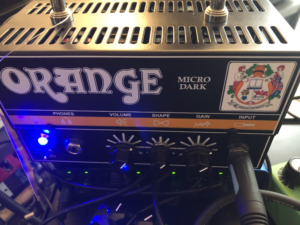
On the back are located the cab out jack and the FX send / return jacks : this small amp does have an FX loop.
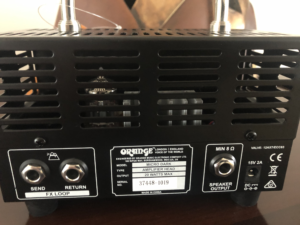
It is really tiny, looks like a toy, and it is the model with the highest level of gain available in the tiny amps range from Orange.
This small amps weights 805 grams on my kitchen scale :
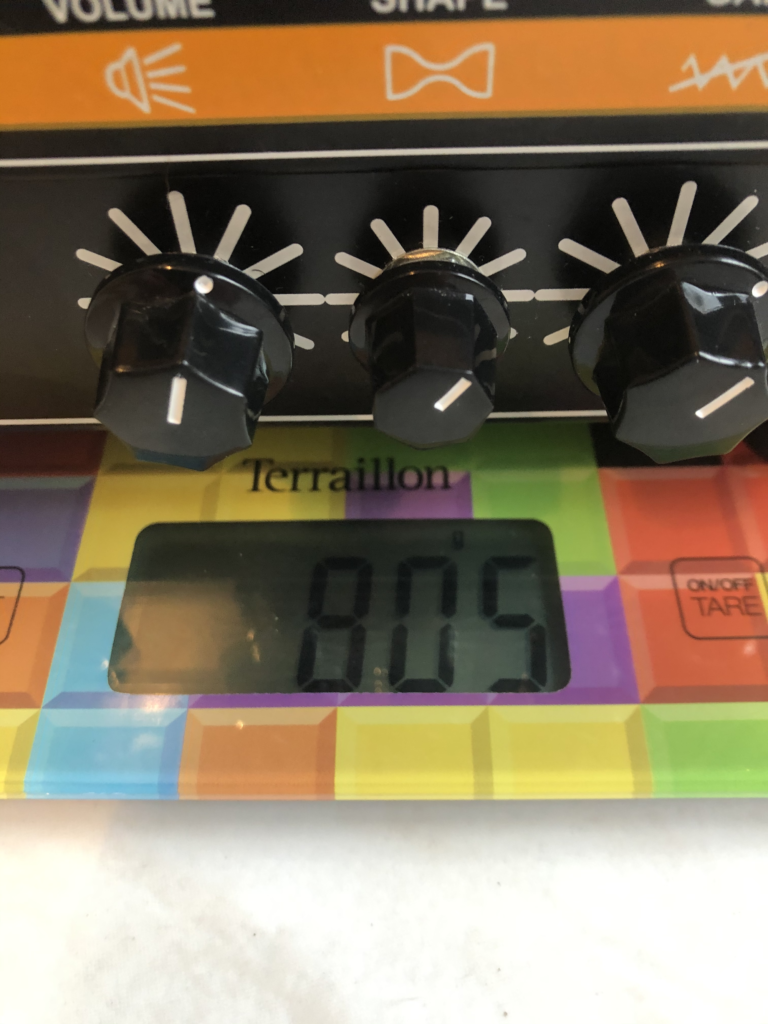
Usage and tone
Plug your guitar, plug your guitar cab (8 ohms minimum) and adjust the shape knob. To the left : more mids, to the right : less mids and a more scooped tone. Adjust your gain level and here you go : you get immediately that Orange thick and inspiring tone. The response to the player’s touch is pleasing and convincing. While this tiny amp has quite some gain, you may find that the distortion squashes a bit too much when turned up too high and you may have to turn the shape more to the right side to get some clarity as the base tone is really …. well.. dark…(that is a little bit expected given the name of the amp ;))
More seriously, it can’t really compete with a full tube amp as it clearly lacks clarity and harmonics. That is especially the case for low notes. Your 6th and 5th strings may sound a little bit dull or synthetic when plugged to a real cab, but for higher notes, the amp produces a very good and convincing tube-like tone. Less rich and full that a real tube amp, but quite amazing for a single valve and transistors amp ! It can get loud when plugged into a 1*12 or a 2*12.
The best results I get are when using an overdrive in front of it : with the exception of a sharp pickup like an EMG 81, I’d have trouble not to use an OD in front of this small amp… Using an OD allowed me to clean-up my signal, and I could then lower the shape and gains to 6 or 7 o’ clock, as this is where I could get the best tone for my taste and playing. And dialing-in some drive from the overdrive pedals can help raising the overall gain without the tone being squashed too much. This is the setup where I can personally get the most interesting tones from this amp.
When paired with a cab, it can get surprisingly loud : still, you can manage to get a fairly useable tone at low to very low volume.
Another interesting use, in my opinion, is to associate the Micro Dark with an IR loading device : I have been using this amp lately a lot for practice, plugged directly into my Torpedo CAB M (the chain I used is Micro Dark -> FX send -> CAB M) and I got the best results with the CAB M 6L6 simulation turned on (but YMMV). Paired with V30 or G12T75 IRs, I find the results to be very good and while there is less high frequencies compared to a real tube amp, there is also less sizzle and less hear fatigue…and this is pretty cool for long practice sessions with headphones (CAB M -> SoundCard -> Headphones). As mentioned above, I personally get the best results with an overdrive in front of it (for instance a Mooer Green Miles, a Maxon OD9 or an Horizon Devices Precision Drive for down-tuned guitars), raising the tone setting on the overdrive pedal to get more clarity, and a little touch of drive/gain on the pedal to get the desired amount of distortion and resonance.
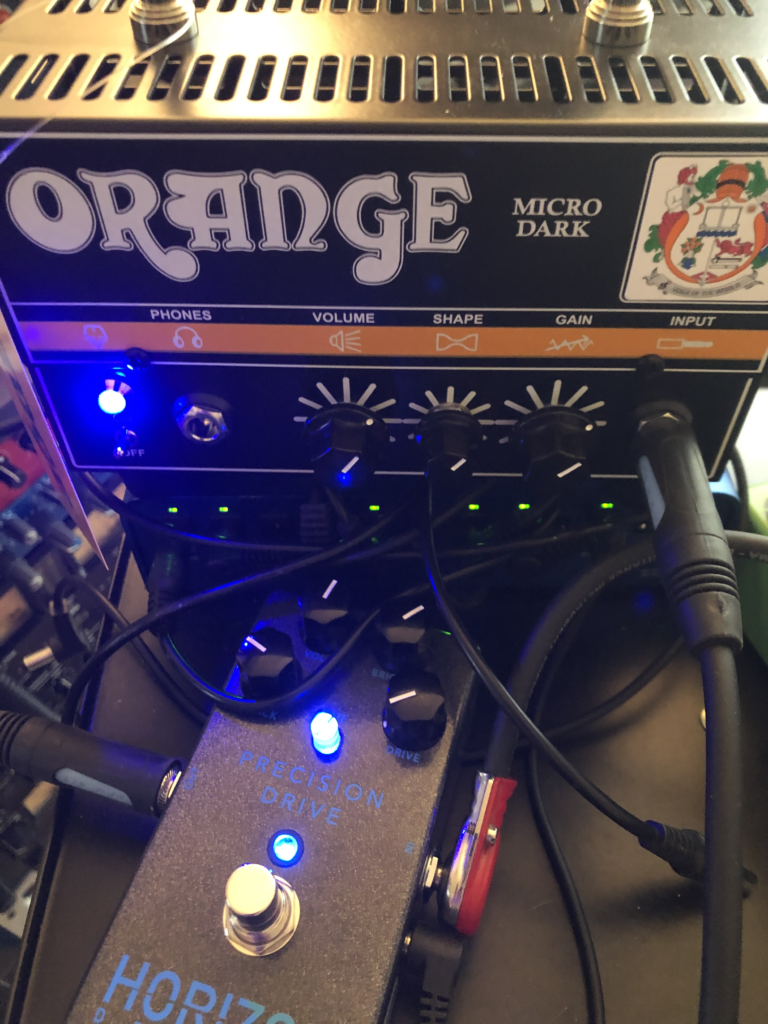
On real guitar cabinets
I tested it with an Orange PPC 112 with a Vintage 30 : you get quite a nice tone (need to raise the highs as the PPC 112 is pretty dark itself), a Zilla Fatboy loaded with a WGS ET65 and a VET30 : nice tone as well. With a Mesa 212 Recto, it was not so nice and too scooped with too much highs for my use.
The samples below are recordings of actual cabinets plugged to the Micro Dark, at relatively low volume (2 out of 10 approximately). So they are using the power section of the Micro Dark. Some of the samples include variations of the microphone positions, variation in the overdrive settings and off/on/off of overdrive pedals.
The samples are using :
- Nazgul pickup (Drop C#)
- SH6 pickup (Drop C)
- SH4 pickup (C tuning)
Overdrive pedals used :
- Maxon OD808
- Moeer Buffer and Mooer Green Miles
- TC Electronic Spark + Fortin Grind
Cabinets used :
- Orange PPC112 – Vintage 30
- Engl E112 – Hesu Demon
- Zilla Fatboy with WGS Vet30 and WGS ET-65
- Mesa 112 Recto
Most samples are recorded with an SM57. One sample uses a ribbon mic, to show that this small amp does have some low-end. In some of these examples, the microphone is moved around to provide multiple tone examples with the same cab.
Samples with IRs
Here is a first set of samples : they were created with the following setups :
- Legator Hive 7 + TC Spark as pre-boost + Precision Drive + Micro Dark Fx out to CAB M
- Seymour Duncan SH6 + Mooer Buffer (low cut on) + Mooer Green Miles + Micro Dark Fx out to CAB M
- Seymour Duncan SH6 + Mooer Buffer (low cut on) + Mooer Green Miles + Micro Dark Fx out to Mooer Radar Pedal
- Seymour Duncan Nazgul + Mooer Buffer (low cut on) + Mooer Green Miles + Micro Dark Fx out to CAB M
The Hive 7 sample is in B tuning, the Nazgul in Drop C# and the SH6 in Drop C. The IRs used are listed in the sample names. The U19 preset on the Radar is a “UK Citrus” (ie an Orange 412) and the U25 is a Diezel cab loaded with G12H55 G12-65Heritage speakers.
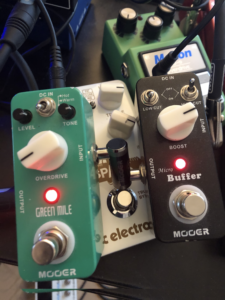
The FX loop
It works… I use the FX Send jack to directly feed a Torpedo CAB M+ or the Mooer Radar loader. Tried the loop also with a chorus pedal, and it was working well.
The headphones output
Well…. It is there but it sounds really harsh. Barely useable from my point of view, or may be in clean/low-gain (I did not try). Still good to have it as a backup capability….
Conclusion
Way more convincing that many distortion pedals, and way more versatile as it can power a real cab, this little amp can provide great tone on a budget, for practice and even small gigs. Pair it with an overdrive and you get a great budget friendly tone machine.
If you A/B it against a full tube amp, you will notice that its sound is less rich than the one produced by an all-tubes amps and is more synthetic (with less bottom end, and less highs) but once you tweak it, pair it with an overdrive and take a couple of minutes to get used to it, you’ll stop noticing and will enjoy a very useable tone for distorted guitars. It works quite well in my personal case with down-tuned guitars (Drop C, B, Drop B,…) and aggressive pickups (SH6) as well as extended range guitars. I really enjoy using it with G12T75 IRs from this collection : https://overdriven.fr/overdriven/index.php/ir-overdriven-212-celestion-g12-t75-home-studio-edition-free-guitar-cab-impulse-responses-download/ (especially with DYN-GB-1 IRs).
Be warned that the base tone is really dark and thick : for metal, you will have to use an overdrive to clean-up the signal low-end (or may be use an EQ in the loop, but I did not try that) and you will probably have to raise your highs to get some good tone. Beware of the samples I provided: there is an heavy clean-up of the low-end. A good overdrive pedal will allow you to tighten your low end and leverage the tone of this small beast.
The shape and gains knobs helps a lot and are quite efficient : I personally got the best tone when helping the small amp distortion by adding drive from my overdrive pedals : it brings more resonance, and it helps avoiding to squash the signal too much. Associated with bright IRs to counter-balance a little bit the lack of highs, it produces a really enjoyable tone, IMHO.
I have been using this small amp for practice daily since one month, and I really enjoy its voicing ! Very fun to play !
Thomann, 185 Euros, November 1, 2020 : https://www.thomannmusic.com/intl/orange_micro_dark.htm
Sonovente, 179 Euros, November 1, 2020 : https://www.sonovente.com/en-gb/orange-micro-dark-p50263.html
Pour Les Musiciens, 185 Euros, November 1, 2020 : https://www.pourlesmusiciens.com/en/orange-micro-dark_95806.html
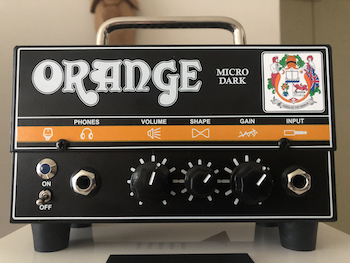
2025-03-03 at 16:56
Thanks for the detailed post! This is the first information I’ve come across for the Micro Dark that actually addresses the tone situation when trying to have any sort of overdriven tone. Cause upping the gain, as the rest of the internet says, is not it. 🤣 But yes it very much squashing the signal. I love the high-gain fuzz it produces on its own, I just haven’t played around much with OD pedals, the two I have are very okay.
Anyways thanks for the insight, I can’t wait to get started playing more with these ideas!